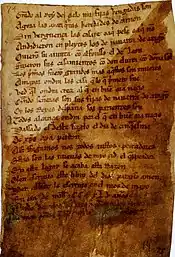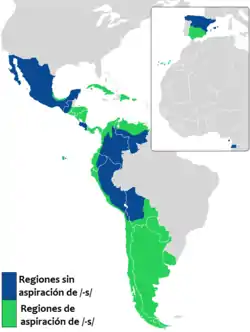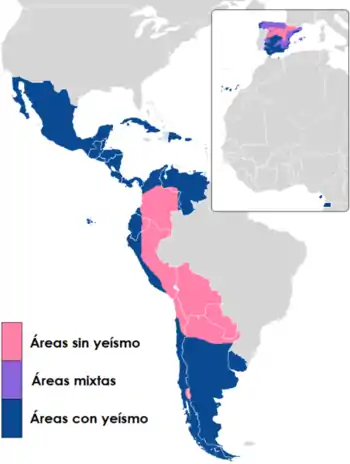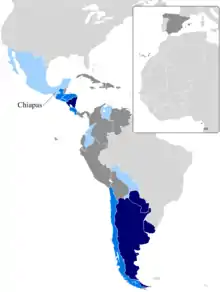Paraguayan Spanish
Paraguayan Spanish (Spanish: español paraguayo) is the set of dialects of the Spanish language spoken in Paraguay. In addition, it influences the speech of the Argentine provinces of Misiones, Corrientes, Formosa, and, to a lesser extent, Chaco. Paraguayan Spanish possesses marked characteristics of Spanish previously spoken in northern Spain, because the majority of the first settlers were from Old Castile and the Basque Country.
| Paraguayan Spanish | |
|---|---|
| Español paraguayo | |
| Native to | Paraguay |
Native speakers | 6 million (2014)[1] |
Indo-European
| |
| Latin (Spanish alphabet) | |
| Official status | |
Official language in | |
| Regulated by | Academia Paraguaya de la Lengua Española |
| Language codes | |
| ISO 639-1 | es |
| ISO 639-2 | spa[2] |
| ISO 639-3 | – |
| Glottolog | None |
| IETF | es-PY |
| Spanish language |
|---|
 |
| Overview |
| History |
| Grammar |
| Dialects |
| Dialectology |
| Interlanguages |
| Teaching |
The Guarani language is co-official with Spanish in Paraguay,[3] and most Paraguayans speak both languages.[4] Guaraní is the home language of more than half the population of Paraguay, with higher proportions of its use in rural areas, and those who speak Spanish at home slightly in the majority in the cities.[5] In addition to the strong influence of Guarani, Paraguayan Spanish is also influenced by River Plate Spanish due to the geographical, historical, and cultural proximity, as well as the sharing of features such as voseo, which is "the use of vos as a second-person singular pronoun."[6] Paraguayan Spanish is notable for its lack of yeismo, meaning that the phonemes /ʎ/ (spelled <ll>) and /ʝ/ (spelled <y>) are distinguished.
The Swedish linguist Bertil Malmberg visited Paraguay in 1946 and observed several features of Spanish pronunciation that he attributed to Guaraní influence.[7] The Guaraní origin of many of these features, however, has been questioned by other researchers, who document them in dialects not in contact with Guaraní.[8]
Characteristics
Overview
The unique features of Paraguayan Spanish developed in part due to Paraguay's early isolation; for example, José Gaspar Rodríguez de Francia, the country's president until 1840, sealed Paraguay's borders. Other experiences with geographic, political, and economic isolation relative to its neighbours allowed Spanish spoken in Paraguay to develop its own unique characteristics, even apart from the wide-ranging influence of Guarani.[3]
Paraguay is, depending on the context, considered part of a region of South America known as the Southern Cone (Spanish: Cono Sur; Portuguese: Cone Sul). In its truest definition, the region consists of Chile, Argentina, and Uruguay, but can be expanded to include Paraguay and some regions of Brazil (Paraná, Rio Grande do Sul, Santa Catarina, and São Paulo). Excluding Brazil (where Portuguese is spoken), all the countries in that region have many similarities in vocabulary. Paraguayan Spanish shares many similarities with River Plate Spanish (that is, the variety spoken in Argentina and Uruguay) such as the use of the voseo and various words and phrases.
- Like all American dialects of Spanish, Paraguayan Spanish has seseo, so that it lacks the distinction between /θ/ and /s/ that is present in Standard European Spanish.
- Syllable-final /r/ is pronounced as [ɹ] (as in American English red) before /l/ or /s/, influenced by a substrate from Native American languages; perla ('pearl') and verso ("verse") are pronounced [ˈpeɹla] and [ˈbeɹso].
- Absence of yeísmo, the historical merger of the phoneme /ʎ/ (spelled <ll>) with /ʝ/ (spelled <y>). For speakers with yeísmo, the verbs cayó 's/he fell' and calló 's/he fell silent' are homophones, both pronounced [kaˈʝo]. (In dialects that lack yeísmo, maintaining the historical distinction, the two words are pronounced respectively [kaˈʝo] and [kaˈʎo].) Yeísmo characterizes the speech of most Spanish-speakers both in Spain and in the Americas.
Main Characteristics
- Absence of yeísmo, the pronunciation of the digraph <ll> as a palatal lateral consonant [ʎ] is different from that of the <y> that is articulated most of the time as an affricate consonant [dʒ].
- Voseo: pronominal and verbal, identical to River Plate Spanish.
- Leísmo: when one uses le in the context of a direct object pronoun instead of the personal pronouns lo and la.
- Contains less pauses and less "musical" intonation than River Plate Spanish.
- Lexicon borrowed from Guarani, Lunfardo, and other European languages.
Pronunciation
First of all, the heterogeneity of the following characteristics are not always applicable to all Paraguayan Spanish speakers, specifically the pronunciation of the letters "r" and "s," which differ according to the social environment.
- The grouping "tr" is pronounced as a voiceless postalveolar affricate [tɹ̥̝], similar to the sound of the digraph /ch/.
- Assibilation of the "r".
- Wide diffusion of the labiodental [v] for the phoneme /b/.
- Word-final /n/ has alveolar articulation, not velar.
- Non-aspirated realization of /x/.
- Hiatus conservation.
- Stable vowel system.
- Weak articulation of /b/, /d/, and /g/ in intervocalic position (and even initial position).
- In some variations of Paraguayan Spanish the "rr" is not pronounced as an alveolar trill, as done by many of the Spanish-speaking regions, but as a [ɹ̝] similar to the English R or how the Sicilian R is done in Italy.
- Use of the alveolar approximant [ɹ] for the pre-consonantal and final "r," similar to the pronunciation in American or Dutch English. Example: firmar [fiɹ.maɹ]
Dynamics of Guarani-Spanish
Typical Paraguayan Spanish has a strong influence of the sentences of Guarani in its translation to Spanish, as well as the words and borrowed particles of Guarani for colloquial expressions. These are some common cases:
- Guarani particles among Castilian words to emphasize expressions. Examples:
- -na ("por favor"). E.g.: Vamos na = Vamos por favor
- -pa, -pió, -piko, -ta (interrogative particle without translation). E.g.: ¿Para qué pa?, ¿Para qué pió? = ¿Para qué?
- -ko, -nio, -ngo (particle to emphasize something). E.g.: Ese ko es de ella.
- Words taken from Guarani for use in everyday Spanish. Examples:
- -gua'u (falsehood). E.g.: De gua'u nomás era = Era solo una mentira.
- ¡Mbore! (exclamation, rejecting something). Synonymous with: ¡Ni loco!
- ¡Kore!, ¡Nderakore! (exclamation, colloquially used for something terrible). Synonymous with: ¡Oh No!
- Sentences taken from Guarani translated partially or erroneously translated for use in everyday Spanish. Examples:
- "Se fue en Itauguá" (from the Guarani "oho Itauguápe", since the 'pe' is used interchangeably as 'a' or 'en')
- "Voy a venir" (literally from the Guarani "aháta aju", used as a synonym of "voy y vuelvo")
- "Vení un poco" (calque of the word "ejúmina" in Guarani)
- "Demasiado mucho calor hace" (calque of the word "hetaiterei" in Guarani)
- "Te dije luego" (from the Guarani "ha'e voi ningo ndéve", in which the "luego" emphasizes the previous action)
- "Me voy a ir ahora después" (calque of the Guarani sentence "aháta aga upéi", in which the "ahora" emphasizes when the action will take place)
- "Habló por mi" (literally from the Guarani "oñe'ẽ cherehe", used as a synonym of "habló de mi")
- Paraguayisms, words and sentences in Spanish, but influenced by Guarani. Examples:
- "Me hallo" ("hallar" is used as a synonym for "alegrar" instead of indicating the location situation)
- "Anda por su cabeza" (influenced by the Guarani "oiko iñakãre", which would be "hace lo que quiere, sin control, sin juicio")
- "Te voy a quitar una foto" ("quitar" is used as a synonym for "sacar" or "tomar" in the case of taking pictures)

Similarities with the River Plate Dialect
Due to the geographical and cultural proximity, both dialects are often confused. This is due to the fact that on the border between Argentina and Paraguay, the respective dialects fuse, creating a northeastern Argentine variety very similar to Paraguayan Spanish in the provinces already mentioned.[9] Examples:
Voseo
Voseo is a peculiar characteristic of Paraguayan Spanish which is heavily influenced by the River Plate dialect (since historically in Paraguay Guarani was always spoken, and Spanish was relegated to the inhabitants of the capital or the most favored classes in the interior of the country). Another characteristic of voseo is how long it has been around for. "Voseo is the oldest form of Castilian Spanish".[10] After the second half of the 20th century, the teaching of voseo depended on whether the teacher used vos or not. Adding to the strong Argentinian influence, either by the media or by the geographical and cultural proximity, voseo stayed as a distinctive characteristic of Paraguayan. Although it is rarely taught in schools today, voseo is beginning to regain some popularity in the form of an accepted regional dialect.[10]
Similarities and Differences in Spanish dialects
| Paraguayan | Rioplatense | Chilean | Castilian | Mexican | Colombian | Cuban | |
|---|---|---|---|---|---|---|---|
| apricot | damasco | damasco | damasco | albaricoque | chabacano | albaricoque | damasco |
| artichoke | alcachofa | alcaucil | alcachofa | alcachofa | alcachofa | alcachofa | alcachofa |
| avocado | aguacate | palta | palta | aguacate | aguacate | aguacate | aguacate |
| banana | banana | banana | plátano | plátano | plátano | banano | plátano |
| bean | poroto | poroto | poroto | judía/alubia | frijol | frijol | frijol |
| bell pepper | locote | morrón | pimentón | pimiento | pimiento | pimentón | pimiento |
| car | auto | auto | auto | coche | carro | carro | carro |
| cashew | castaña de cajú | castaña de cajú | castaña de cajú | anacardo | nuez de la India | marañón | marañón |
| cell phone | celular | celular | celular | móvil | celular | celular | celular |
| clothes hanger | percha | percha | colgador | percha | gancho | gancho | perchero |
| computer | computadora | computadora | computador | ordenador | computadora | computador | computadora |
| corn on the cob | choclo | choclo | choclo | mazorca | elote | mazorca | mazorca |
| gasoline | nafta | nafta | bencina | gasolina | gasolina | gasolina | gasolina |
| grapefruit | pomelo | pomelo | pomelo | pomelo | toronja | toronja | toronja |
| green bean | chaucha | chaucha | poroto verde | judía verde | ejote | habichuela | habichuela |
| panties | bombacha | bombacha | calzón | braga | calzón | calzón | blúmer |
| papaya | mamón | papaya | papaya | papaya | papaya | papaya | fruta bomba |
| pea | arveja | arveja | arveja | guisante | chícharo | arveja | chícharo |
| peach | durazno | durazno | durazno | melocotón | durazno | durazno | melocotón |
| peanut | maní | maní | maní | cacahuete | cacahuate | maní | maní |
| potato | papa | papa | papa | patata | papa | papa | papa |
| sock | media | media | calcetín | calcetín | calcetín | media | media |
| soy | soja | soja | soya | soja | soya | soya | soya |
| straw | pajita | pajita | bombilla | pajita | popote | pitillo | absorbente |
| strawberry | frutilla | frutilla | frutilla | fresa | fresa | fresa | fresa |
| t-shirt | remera | remera | polera | camiseta | playera | camiseta | pulóver |
| washing machine | lavarropas | lavarropas | lavadora | lavadora | lavadora | lavadora | lavadora |
Dialects of Spanish in Paraguay
Andean Spanish
See also
- Paraguay–Spain relations
- Academia Paraguaya de la Lengua Española
- Jopará - The colloquial form of Guarani that uses large numbers of Spanish loan words.
- Paraguayan Guaraní (dialect)
- Paraguayan Academy of Language
- Yopará
References
- Spanish → Paraguay at Ethnologue (18th ed., 2015)
- "ISO 639-2 Language Code search". Library of Congress. Retrieved 22 June 2019.
- Simon Romero, "An Indigenous Language With Unique Staying Power", The New York Times, March 12, 2012
- William R. Long, "Native Guarani Vies with Spanish Paraguay's 2 Languages Source of Pride, Concern", Los Angeles Times, April 13, 1988
- J. K. Choi, 2005, "Bilingualism in Paraguay: Forty Years After Rubin's Study". Journal of Multilingual and Multicultural Development, 26(3), 233-248, as cited by Sarah Gevene Hopton Tyler, 2010, "Intergenerational Linguistic Changes to the Spanish Dialect of Three Participant Groups from Greater Asunción (Paraguay)", M.A. thesis, University of North Carolina at Greensboro, p. 3.
- Gerardo, Kayser (2001). El dialecto rioplatense = The River Plate dialect. Buenos Aires: Editorial Dunken.
- Luis Flórez, review of Malmberg's Notas sobre la fonética del español en el Paraguay (Lund: C. W. K. Gleerup, 1947), in Thesaurus: Boletín del Instituto Caro y Cuervo, 6 (1950), 301.
- For example Paul Cassano, "The Substrat Theory in Relation to the Bilingualism of Paraguay: Problems and Findings", in Anthropological Linguistics, 15 (1973), 406-426, as cited in D. Lincoln Canfield, Spanish Pronunciation in the Americas (Chicago: University of Chicago Press, 1981), p. 70.
- Barrenechea, Ana María. "Estudios lingüísticos y dialectológicos: Temas hispánicos". Hachette Universidad: 115–35.
- "Voseo", Wikipedia, 6 June 2019, retrieved 7 June 2019

